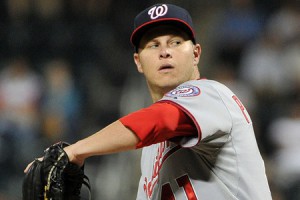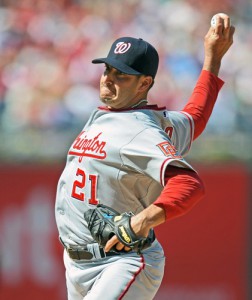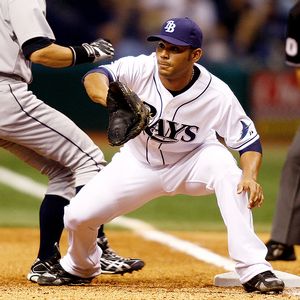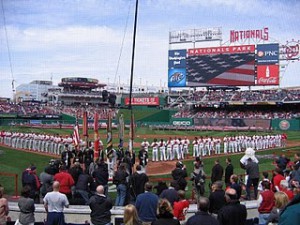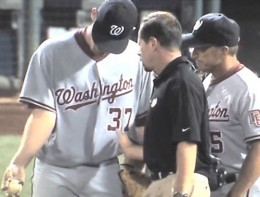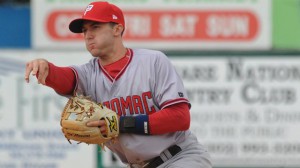
Is this your 2nd baseman/leadoff hitter of the future? Photo via midatlanticredsox.net
Man, back to back chats and inbox responses this week. Boswell did his weekly chat on 8/29/11 and managed to fit in some Nats questions. Here’s how i’d have answered them (you know, if I was a nationally known writer and had thousands of people eagerly asking my opinion on things…).
Q: If Steve Lombardozzi (pictured above) hits during his 9/1 call-up, is it time to move on from Desmond?
A: I’d say not quite. Desmond may have over 1000 major league at bats by now, and clearly has been regressing at the plate over the past few years, but the team loves him and probably gives him one more year before pulling the plug. I think we all know Espinosa can take over at SS and that Lombardozzi is a great fit at 2b/leadoff. The problem is; how do you evaluate Lombardozzi if you want to play Espinosa every day? Boswell says Desmond will be a tough call, but says he’s coveted by other teams. A trade may be in the future.
Q: Why didn’t the Nats factor into trades for CFs Rasmus or Bourn?
A: Good question frankly. The team was making noise about wanting a CF all spring and all summer. The questioner called the trade packages “middling” for both players, but I’d hardly call it that. Both acquiring teams gave up good players to get these guys. I think the Cardinals in particular will regret trading Rasmus and may think about what it is about their manager that makes it so difficult to get along with him. Here’s an interesting point: The Nats just don’t trade with either team; there’s only minor league swaps between Washington and Houston/St. Louis over the past decade. Perhaps Rizzo just doesn’t have a relationship with the GMs there. Or more to the point, the Nats probably didn’t want to give up what it was going to take to get a guy like Rasmus (likely one of our good starters as it cost Toronto). Boswell thinks the Nats didn’t want to overspend on a CF since Werth can play there and we have a couple of CF prospects (specifically mentioning Goodwin) that could fit in there later.
Q: Should the team take advantage of Harper’s 40-man status to just call him up for the experience?
A: Nope. There’s no reason to give him service time in September, which would delay his 2012 call-up deeper into June. Plus he’s got a pulled hamstring that seemed like a relatively serious issue. The plan is and should stay the same; let him heal, send him to the Arizona Fall League for a bit more playing time, then shut him down til spring training. Boswell says you have to earn call-ups and he doesn’t think Harper did.
Q: Is Davey Johnson the answer at manager? Should we target a younger more inventive mind?
A: It is hard to say. Unlike in other sports, Baseball’s landscape moves slowly. Johnson already embraces most of the “newer” technologies or theories in the sport (advanced sabremetrics, video monitoring, lineup theories, reliever-leverage use). So he should be ok. He clearly deserves respect from his players, both based on his own playing career and his managerial accomplishments. It is a big concerning that the team almost immediately started to underperform once he took the helm … but the team also couldn’t sustain its winning streak that Riggleman tried to make use of when he threatened to, and ultimately, resigned. Boswell points to Davey Johnson’s career W/L percentage and says don’t be too quick to judge. Fair enough.
Q: Since Gorzelanny and Wang cleared waivers, should we try to trade them?
A: Wang no, Gorzelanny yes. Clearly Gorzelanny has fallen out of favor with this manager and the team. Exactly why, i’m not sure; his numbers weren’t really that bad and are almost identical to Livan’s on the season. He’s a lefty and his k/9 rates were the best of any starter on the team. Once banished to the bullpen he didn’t appear for 13 days and had to beg to be used. Sounds like a guy who is surplus to requirements and should be traded. Meanwhile Wang is someone who I doubt anyone else would experiment with at this point in the season. He is still a wild card. Boswell advocates keeping Gorzelanny since he’s under team control through 2013.
Q: Follow up: will the Nats try to hold on to FAs to be Wang and Nix this off season?
A: Wang; it depends on how he does the rest of the way out, clearly. But the team has invested $3M in these 11-12 2011 starts, so hopefully that good will turns into an offer to stay, if it comes to that. Nix? We seem to have too many outfielders. Morse is going to start in left with LaRoche coming back in 2011, so that leaves Nix and Gomes without starting positions. Nix has shown value but he hit better in 2010 and was non-tendered. And his splits against lefties are beyond awful (3-27 on the season). I’m guessing he’s released when the time comes and Gomes is in line to be the 4th outfielder in 2012. Boswell says we should keep Wang if possible, and agrees with Nix being in a numbers game for LF/1B positions.
Q: Why did the Nats call up Marrero before 9/1? Who else do you want to see come up?
A: Marrero filled a 25-man slot vacated by Mattheus, as the Nats had been playing with an extra bullpen guy since the trades. No other special reason. The questioner suggests that Bernadina is coming back up; I hate to say it but I think Bernadina is closer to a release than a callup. We’ll definitely see Strasburg mid-next week. We’ll probably see Lombardozzi, Peacock and Milone. Meyers seems to be in shutdown mode so I doubt we’ll see him. That’s about all I can think of. Boswell points out an interesting tidbit: apparently Rizzo is worried about “exposing” someone off the 40-man if he calls up too many guys. As I pointed out in this space, there’s clearly maneuvering room on the 40-man. Not sure what the problem is. If Rizzo is still obsessed with Garrett Mock, then this team has a bigger problem.
Q: Does the team just have a blind spot when it comes to Center Fielders? Both Nyjer Morgan and Endy Chavez are hitting well for first place teams. Is Rick Ankiel the answer for 2012?
A: Morgan clearly had to go (worn out his welcome). Chavez was a trade in 2005, and we got Marlon Byrd for him. He was nothing in 05 and now suddenly is halfway decent. Hard to fault this team for that. Meanwhile what to do about Ankiel? I think he sticks around for 2012 as at least a 4th outfielder, probably a starter in CF until a prospect is ready. Unless Rizzo pulls of a blockbuster trade (which I doubt). Boswell doesn’t really answer the question, just gripes about Willingham’s production in Oakland.
Q: We have 3 catchers right now. What happens next year?
A: Pudge is a FA and signs elsewhere. And we have Ramos and Flores, with decent depth in Solano (AAA). I don’t think Pudge is coming back; he can find work elsewhere with a contender and get another shot at the postseason. Boswell wants Pudge back instead of Flores … which I’d agree is better but probably not happening.
Q: If lower minor leaguers are continually successful against MLB pitchers on rehab assignments, why don’t MLB hitters adopt the same approach?
A: A great question. I’ve wondered this myself to a certain extent. After watching Strasburg get lit up in Hagerstown but then shut down AAA hitters, you have to wonder what is going on? I’d guess that the answer is something like, “if you swing out of your ass the first time up, you’re not going to see that pitch again and have to adjust. And low-A hitters don’t adjust.” Small sample sizes. Boswell says the kids in low-A got lucky. Sorry that’s a punt. You can see Strasburg’s performances in low-A, AA and compare it to AAA and its night and day. There has to be a better answer.
Q: Should Harper try to make it back for Harrisburg’s AA playoffs?
A: If he’s healthy, why not? Good enough to start, good enough to play. However, if he’s not ready then he’ll continue to stay on the DL. Boswell agrees I guess.
Q: Does Scott Boras ever turn down a player?
A: I’m sure he does, as any agent probably has players he’s turned down. Boswell says he’s selective, but finds it interesting that he represents some common-man players such as Alberto Gonzalez.
Q: How much lead time will we get for Strasburg’s first MLB start back?
A: Probably depends on his last start. If he’s a go, and looks good, they’ll make the announcement the next day. I’m sure they’re not really that worried about ticket sales. Those tickets will go, fast. Boswell reiterates that one rainout blows all well-laid plans.
Q: Ross Detwiler; future trade bait or future rotational starter based on his 2011 numbers?
A: You can do a lot worse than a #5 starter with a sub 3.00 era (which he has for 2011 right now). But we clearly have a surplus of young arms. Assuming that 1-2-3 next year is Strasburg-Zimmermann-Lannan, we have some decisions. Livan? Probably gone. Wang? We’ll see but he could very well be #4 starter next year. Then there’s Milone, Meyers and Peacock chomping at the bit in AAA. And this doesn’t mention Gorzelanny. I’m guessing some of these guys get traded, not sure which. Boswell mentions two good points: Detwiler’s fip is far higher than his ERA, and that Detwiler is out of options so he may stick in 2012 just based on that fact.
Q: Baseball strategy question for you: Bottom of the 10th, runners on first and second, nobody out. Tie game. Batter at the plate is oh-fer, with three Ks, two looking. What do you do?
A: I think its pretty clear you bunt. Trick question b/c this was the situation facing our $126M man Jayson Werth last week. I forgot to take into account a 3-4-5 guy. In the playoffs or in a complete do-or-die situation even Werth bunts in this situation.
Q: What should we expect from Strasburg upon his return?
A: I’d expect decent to good numbers, but nothing other-worldly. He’s still recovering and still working his way back. 2012 we can expect greatness again. Boswell agrees.
http://www.nationalsarmrace.com/?p=2218
